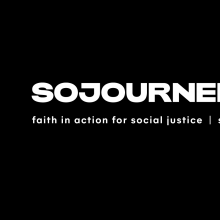Culture
"Here's how you bring light into the world," says a scruffy-bearded man in shirtsleeves and a knit cap on a Brooklyn rooftop. "First, you get up in the morning and you scream!" His mischievous grin melts into something more ethereally content as he screams. At length.
He's had plenty of practice screaming — he does it for a living.
The man is Yishai Romanoff, lead singer of the hassidic punk band Moshiach Oi and one of the half-dozen artists, activists, and culture-makers profiled in the documentary Punk Jews.
The phrase can seem like an oxymoron: The essence of punk is to challenge inherited convention, yet adherence to rich traditions of convention is the common through-line of all of Judaism's myriad flavors.
Life with Purpose
In Visions of Vocation: Common Grace for the Common Good, Steven Garber writes eloquently of the challenge "to see with the eyes of the heart, to see oneself as responsible for the way the world is and isn't" without succumbing to cynicism. IVP Books
Saved Songs
Just months before civil war erupted in Syria, a small group of Syria Sufi musicians known as NAWA were recorded peforming nearly lsot melodies, songs, and poems on Ancient Sufi Invocations and Forgotten Songs from Aleppo. This is the first album in a planned four-part Sacred Voices of Syria series. Cowbell/Lost Origins
I’VE BEEN SPENDING a lot of time with my credit card company lately. Nice people work there, of course, and I try to make every phone call a time of conviviality and respect. It’s what good people do.
Credit card guy: Sir, my name is Brian, and ...
Me: No, it’s not.
“Brian”: I beg your pardon?
Me: Be honest. They give you anglicized names to sound more American, right? So when did you get that name?
“Brian”: When I was born. It’s also my father’s name.
Me: And, you’re calling from, like, Mumbai or ...
Brian: Texas.
Me: [awkward moment of silent self-loathing, mercifully cut short by seeing a butterfly. Pretty.]
But you readers understand my point. American jobs should be for Americans. Honest, God-fearing Americans who embody the spirit of freedom and entrepreneurship. Like the guy in Kansas who, according to Brian, had just purchased an iPad with my credit card number. Brian was calling from Texas to make sure this was okay with me, which it wasn’t.
Don’t get me wrong. I’m all for buying an iPad or any of the high-tech gadgets that I’ve had my eye on. And I totally get that the guy in Kansas feels the same way. In fact, I was cool with him right up to the point where he decided to keep it for himself.
On the monastery walk,
in the clear daylight after
the night of heavy rain,
I consider the moonflower:
how the big spent blooms look like
three linen tea towels rinsed and wrung out,
three yellowed towels someone meant to
pin to the line to dry.
If the new Disney Studios movie Maleficent is, as some are saying, a feminist attempt to redeem images of weak and powerless women in fairy tales, then it is a cautionary tale. Feminism has always been its own worst enemy when it strives to create women in the image of men rather than encourage women to abandon rivalry with men and seek their flourishing elsewhere. This is a story about the redemptive power of a mother’s love. I wonder how many feminists will embrace that message?
YOU DON’T HAVE to be an environmentalist to wonder about technology. Will it be our great savior or another thorn in the flesh, another opportunity to hear Thoreau’s lament about the tendency of humans to “become the tools of their tools”?
This excellent collection of prayers and worship materials, From the Psalms to the Cloud, helps us understand the tool of technology. It is a very green book while also being useful. It is green because it gives us a way out of the totalitarian world of the market and into a world that we make with words.
Just about everybody is on the other side of the “time famine” and the “trust famine” and deep into digital and connectivity overload. By time famine I mean the pervasive sense that there is not enough time to do what we want, so subjugated is our time to technology, forms, and robotic requests for information. By trust famine I mean all that time we spend worrying about time and wondering if somebody else is in charge. Are we in charge of our tools and our time or are our tools and time in charge of us?
In this optimistic book, the prophets arrive. Mankin and Tirabassi ask the right question: Can a technology devoted to advertising be useful to spirituality? They answer with a careful yes, taking us on the long road from the Psalms to Twitter, by way of “vintage wine in vintage wineskins, uncorked.” These two writers gather the wisdom of dozens of beautiful writers of prayers and liturgies and show us a way to go deep digitally. Whether they are praying for energy that will “deeply change all of our clocks,” or for the return of the time when churches giving sanctuary for immigrants will become again “dusty places with pews,” or in any of John Dannon’s exquisite doxologies for the natural and ecclesiastical seasons, or encouraging us to “spend a day saying nothing that doesn’t need saying.” The prayer topics move through addiction to pregnancy to a ritual for quitting a job. What a great ask this is for those confused or overdone with technology: We pray “for a trap door when we hit rock bottom.”
FORGIVENESS IS wholeness, Nobel Peace Prize winner Archbishop Desmond Tutu and his daughter, Anglican minister Rev. Mpho Tutu, write in their newest collaboration,The Book of Forgiving. Scientific research shows that forgiveness has the power to transform us in spiritual, emotional, and even physical ways. That evidence is paired with the Tutus’ collective experience in counseling, studying, and teaching and their personal stories about the difficulty of forgiving. Archbishop Tutu writes about learning to forgive his abusive father. Mpho, who writes about learning to forgive the man who murdered her housekeeper in her home, is pursuing a PhD in the topic of forgiveness.
The book lays out some simple but critical truths: Everyone can be forgiven. Everyone deserves forgiveness. You must be willing to forgive. Forgiveness is not a weakness, nor a luxury. Forgiving others is a way to practice forgiving yourself. Through forgiveness, we all become whole again. Unconditional forgiveness is an act of grace that frees all parties from further indignity, and from self-blame and corrosive hatred.
The path to forgiveness seems simple enough when you can navigate it in four easy-to-follow steps: Tell the story. Name the hurt. Grant forgiveness. Renew or release the relationship. The path is also—sorry—a bit pedestrian. That doesn’t mean the route map isn’t useful. But the book will be most applicable if you have struggled to forgive or feel that even contemplating forgiveness is an impossible burden weighing heavy on your heart and soul. If you’re carrying a load you can’t seem to gracefully shrug off or leave by the side of the road, the Tutus can help you chart the course.
OVER THE PAST 2,000 years, Christians have found myriad ways to divide the body of Christ. We are now more divided than ever, with more than 40,000 Christian denominations worldwide. Perhaps, in this context, we are asking the wrong questions. Do we really understand God’s desire for the church to be one? Do we as individuals have a yearning for the unification of the body of Christ? Why do we create the divisions we create? Why do we maintain the divisions that already exist? How can we break through these barriers to heal a broken church?
Christena Cleveland sets out to answer all of these questions and more in her latest book, Disunity in Christ. Cleveland is a young, energetic, and brilliant teacher, speaker, and researcher in the fields of social psychology and faith and reconciliation. For those concerned with reconciliation in the church, which should be all of us, hers is a voice to take seriously.
In Disunity, Cleveland quickly breaks the ice by poking fun at herself and by pointing to her own personal prejudices and biases that have led to her categorically labeling fellow brothers and sisters in Christ as either a “right Christian” or “wrong Christian.” The reader is immediately able to connect with her and realize the ways in which we have created division in our own lives, whether because of race, gender, orientation, education, location, socio-economic status, theology, or political affiliation. It also becomes apparent why we prefer our homogenous groups.
IN WALT DISNEY’S Tomorrowland, you still have to push the faucet to get water to wash your hands. I know this because I stood waving my soapy hands at the men’s room spigot for about 15 seconds, expecting water to magically appear, as it so often does these days. Finally the guy next to me said, “You have to push it.”
Still recovering from this irony, I left the men’s room and noticed, along the wall outside, a deserted bank of AT&T pay phones. The future, it turns out, just isn’t what it used to be, but then, at Disneyland, neither is the past.
It was a perfect blue, warm, sunny day in mid-April, Wednesday of Holy Week in fact, when I joined the cosmopolitan herd trekking from the Pinocchio parking lot to the gates of Disneyland—the original one, in California. But unlike the other middle-aged people there, I went unencumbered by children, and I didn’t pay $92 to enter the kingdom of Mickey. My trip was a corporate junket related to my higher-ed day job. I was responsible for three college students, but they had their per diem and didn’t need me, so I was free to wander, observe, and refuse to stand in those mile-long lines for the famous rides.
My first stop was on the faux turn-of-the-last-century Main Street, at “Market House.” It looks like an old-time general store, with wide-plank hardwood floors and rough lumber pillars. But closer inspection reveals a Starbucks in disguise: the same pastries, sandwiches, and drinks as at any Starbucks the world over. But the ultimate Disney touch was the small army of young Latina baristas behind the counter in floor-length, puffy-sleeved dresses straight out of Little House on the Prairie.
“I AM A storyteller,” says Daniel Beaty, “and my purpose in the world is to inspire people to transform pain to power.”
He was first inspired to share his stories when his third-grade teacher showed a videotape of Martin Luther King Jr.’s “I Have a Dream” speech. Now as a writer, actor, singer, teacher, and motivational speaker, his storytelling is expressed in a dizzying array of different forms and outlets. The week in April that Sojourners’ editorial assistant Rebecca Kraybill interviewed him, Beaty was doing daily performances in Los Angeles of a one-person play he wrote on the life of performer and activist Paul Robeson, “The Tallest Tree in the Forest” (in which he plays 40 characters and sings 14 songs) and, during the day, taping for a Ford Foundation-funded documentary on work he does with children of incarcerated parents.
This was just a fortnight after Beaty finished a six-week speaking tour in support of his memoir, Transforming Pain to Power: Unlock Your Unlimited Potential (Penguin-Random House). He’s also the author of a children’s book released in December 2013 by Little, Brown and Company, Knock Knock: My Dad’s Dream for Me, with graphics by award-winning illustrator Bryan Collier, which is an adaptation of a poem Beaty wrote about his experience growing up with an incarcerated father. “Knock knock down the doors that I could not” is one especially poignant line the father in the book writes to the son; it carries a call to healing and liberation that is found in all of Beaty’s work.
Kraybill talked with Beaty about the effects of mass incarceration on families, the power of a “theater sanctuary,” and how the arts call us toward “the capacity to do better.”
When I heard the news I wept.
“Renowned Poet and Author Maya Angelou Dies at 86,” read the NBC News headline.
My fruitless effort to hold back tears was proven vain as I made my way into the bowels of a D.C. Metro station — tears streaming. I felt silly.
“Why am I crying,” I thought. “I didn’t know Maya Angelou.” I met her once, but she wasn’t family or a close friend, yet I was reacting with the same profound sense of loss, as if my own beloved great grandmother had passed?
The New York Times called her a “lyrical witness of the Jim Crow South” in the headline that announced Ms. Angelou’s death this morning. But for nearly four decades Dr. Maya Angelou served as a kind of great grandmother of the African-American community — a bridge between the ancestors and us.
The last time I listened to Nickel Creek was to analyze their adaptation of Robert Burns’ poem, “Sweet Afton,” in my English literature class in college three years ago. Indeed, the waters of Nickel Creek flow gently, a trait reflected in “Sweet Afton” and many other Nickel Creek staples. And that general lack of bite, paired with an almost robotic mastery of each band members’ respective instrument, pushed me away from the band.
So it was strange that, with no expectations and an arbitrarily negative perception of the classic folk band, I really enjoyed seeing Nickel Creek reunite in Washington, D.C. after a six-year hiatus. The show, in sum, was really, really good.
Amanda Gross describes herself as a “weaver of things and people.”
Gross, a fiber artist based in Pittsburgh, Pa., has been weaving things — from quilts to bags to skirts — for years. But, as a “weaver of people,” Gross completed her biggest project yet this fall.
Gross is the head artist behind the Knit the Bridge project, a massive community effort that covered the Andy Warhol Bridge in Pittsburgh with knit and crochet panels. From August to September, Knit the Bridge workers installed 600 handmade blankets across the 1,061-ft. long bridge.
I was born in 1990. That puts me squarely in the middle of what is referred to as the millennial generation.
It also, apparently, makes me a lazy, entitled, narcissist who still lives with my parents.
But that’s beside the point. What’s more important about the date of my birth is that it places me at a distinct and pivotal point in human history: I grew up with the Internet — what they call a “digital native.”
I (vaguely) remember when the Internet got popular; having slow, dial-up that made lots of crazy noises whenever you wanted to use it; talking to other angsty teens on AOL Instant Messenger (“AIM”); downloading music on Napster and Kazaa; and then, slowly but surely, having the Internet became engrained in my everyday life as if it was there the whole time.
But, like the bratty sibling I grew up with (upon reflection, I was equally, if not more, bratty — #humility #perspective), I’ve recognized that I have a love/hate relationship with the Internet. It’s a game-changer for the human experience, so, like that sibling, I think I’ll always love it. But, for every positive, innovative element of the Internet there is an equal and opposite reaction.











